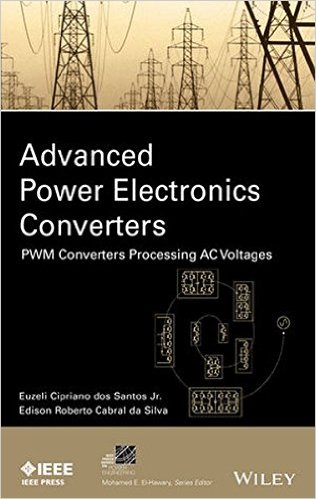 [内容简介]
[内容简介]
This book covers power electronics, in depth, by presenting the basic principles and application details, which can be used both as a textbook and reference book.
- Introduces a new method to present power electronics converters called Power Blocks Geometry (PBG)
- Applicable for courses focusing on power electronics, power electronics converters, and advanced power converters
- Offers a comprehensive set of simulation results to help understand the circuits presented throughout the book
[目录]
PREFACE xi
CHAPTER 1 INTRODUCTION 1
1.1 Introduction 1
1.2 Background 3
1.3 History of Power Switches and Power Converters 4
1.4 Applications of Power Electronics Converters 6
1.5 Summary 9
References 9
CHAPTER 2 POWER SWITCHES AND OVERVIEW OF BASIC POWER CONVERTERS 10
2.1 Introduction 10
2.2 Power Electronics Devices as Ideal Switches 11
2.2.1 Static Characteristics 12
2.2.2 Dynamic Characteristics 12
2.3 Main Real Power Semiconductor Devices 16
2.3.1 Spontaneous Conduction/Spontaneous Blocking 17
2.3.2 Controlled Conduction/Spontaneous Blocking Devices 18
2.3.3 Controlled Conduction/Controlled Blocking Devices 19
2.3.4 Spontaneous Conduction/Controlled Blocking Devices 22
2.3.5 List of Inventors of the Major Power Switches 24
2.4 Basic Converters 25
2.4.1 dc–dc Conversion 28
2.4.2 dc–ac Conversion 33
2.4.3 ac–dc Conversion 43
2.4.4 ac–dc Conversion 49
2.5 Summary 50
References 52
CHAPTER 3 POWER ELECTRONICS CONVERTERS PROCESSING ac VOLTAGE AND POWER BLOCKS GEOMETRY 56
3.1 Introduction 56
3.2 Principles of Power Blocks Geometry (PBG) 58
3.3 Description of Power Blocks 62
3.4 Application of PBG in Multilevel Configurations 67
3.4.1 Neutral-Point-Clamped Configuration 68
3.4.2 Cascade Configuration 72
3.4.3 Flying Capacitor Configuration 75
3.4.4 Other Multilevel Configurations 79
3.5 Application of PBG in ac–dc–ac Configurations 81
3.5.1 Three-Phase to Three-Phase Configurations 82
3.5.2 Single-Phase to Single-Phase Configurations 85
3.6 Summary 85
References 87
CHAPTER 4 NEUTRAL-POINT-CLAMPED CONFIGURATION 88
4.1 Introduction 88
4.2 Three-Level Configuration 89
4.3 PWM Implementation (Half-Bridge Topology) 93
4.4 Full-Bridge Topologies 95
4.5 Three-Phase NPC Converter 98
4.6 Nonconventional Arrangements by Using Three-Level Legs 101
4.7 Unbalanced Capacitor Voltage 108
4.8 Four-Level Configuration 112
4.9 PWM Implementation (Four-Level Configuration) 115
4.10 Full-Bridge and Other Circuits (Four-Level Configuration) 118
4.11 Five-Level Configuration 119
4.12 Summary 124
References 124
CHAPTER 5 CASCADE CONFIGURATION 125
5.1 Introduction 125
5.2 Single H-Bridge Converter 126
5.3 PWM Implementation of A Single H-Bridge Converter 129
5.4 Three-Phase Converter—One H-Bridge Converter Per Phase 140
5.5 Two H-Bridge Converters 144
5.6 PWM Implementation of Two Cascade H-Bridges 146
5.7 Three-Phase Converter—Two Cascade H-Bridges Per Phase 149
5.8 Two H-Bridge Converters (Seven- and Nine-Level Topologies) 162
5.9 Three H-Bridge Converters 164
5.10 Four H-Bridge Converters and Generalization 169
5.11 Summary 169
References 170
CHAPTER 6 FLYING-CAPACITOR CONFIGURATION 172
6.1 Introduction 172
6.2 Three-Level Configuration 173
6.3 PWM Implementation (Half-Bridge Topology) 177
6.4 Flying Capacitor Voltage Control 179
6.5 Full-Bridge Topology 181
6.6 Three-Phase FC Converter 183
6.7 Nonconventional FC Converters with Three-Level Legs 186
6.8 Four-Level Configuration 189
6.9 Generalization 196
6.10 Summary 197
References 198
CHAPTER 7 OTHER MULTILEVEL CONFIGURATIONS 199
7.1 Introduction 199
7.2 Nested Configuration 200
7.3 Topology with Magnetic Element at the Output 205
7.4 Active-Neutral-Point-Clamped Converters 211
7.5 More Multilevel Converters 214
7.6 Summary 218
References 219
CHAPTER 8 OPTIMIZED PWM APPROACH 221
8.1 Introduction 221
8.2 Two-Leg Converter 222
8.2.1 Model 222
8.2.2 PWM Implementation 223
8.2.3 Analog and Digital Implementation 228
8.2.4 Influence of for PWM Implementation 231
8.3 Three-Leg Converter and Three-Phase Load 233
8.3.1 Model 233
8.3.2 PWM Implementation 235
8.3.3 Analog and Digital Implementation 236
8.3.4 Influence of for PWM Implementation in a Three-Leg Converter 236
8.3.5 Influence of the Three-Phase Machine Connection over Inverter Variables 238
8.4 Space Vector Modulation (SVPWM) 243
8.5 Other Configurations with CPWM 247
8.5.1 Three-Leg Converter—Two-Phase Machine 247
8.5.2 Four-Leg Converter 249
8.6 Nonconventional Topologies with CPWM 252
8.6.1 Inverter with Split-Wound Coupled Inductors 252
8.6.2 Z-Source Converter 254
8.6.3 Open-End Winding Motor Drive System 257
8.7 Summary 261
References 261
CHAPTER 9 CONTROL STRATEGIES FOR POWER CONVERTERS 264
9.1 Introduction 264
9.2 Basic Control Principles 265
9.3 Hysteresis Control 271
9.3.1 Application of the Hysteresis Control for dc Motor Drive 275
9.3.2 Hysteresis Control for Regulating an ac Variable 278
9.4 Linear Control—dc Variable 279
9.4.1 Proportional Controller: RL Load 279
9.4.2 Proportional Controller: dc Motor Drive System 280
9.4.3 Proportional-Integral Controller: RL Load 283
9.4.4 Proportional-Integral Controller: dc Motor 285
9.4.5 Proportional-Integral-Derivative Controller: dc Motor 286
9.5 Linear Control—ac Variable 288
9.6 Cascade Control Strategies 289
9.6.1 Rectifier Circuit: Voltage-Current Control 289
9.6.2 Motor Drive: Speed-Current Control 290
9.7 Summary 293
References 293
CHAPTER 10 SINGLE-PHASE TO SINGLE-PHASE BACK-TO-BACK CONVERTER 295
10.1 Introduction 295
10.2 Full-Bridge Converter 296
10.2.1 Model 296
10.2.2 PWM Strategy 297
10.2.3 Control Approach 298
10.2.4 Power Analysis 299
10.2.5 dc-link Capacitor Voltage 301
10.2.6 Capacitor Bank Design 304
10.3 Topology with Component Count Reduction 307
10.3.1 Model 307
10.3.2 PWM Strategy 308
10.3.3 dc-link Voltage Requirement 309
10.3.4 Half-Bridge Converter 310
10.4 Topologies with Increased Number of Switches (Converters in Parallel) 310
10.4.1 Model 311
10.4.2 PWM Strategy 315
10.4.3 Control Strategy 316
10.5 Topologies with Increased Number of Switches (Converters in Series) 318
10.6 Summary 321
References 321
CHAPTER 11 THREE-PHASE TO THREE-PHASE AND OTHER BACK-TO-BACK CONVERTERS 324
11.1 Introduction 324
11.2 Full-Bridge Converter 325
11.2.1 Model 325
11.2.2 PWM Strategy 327
11.2.3 Control Approach 328
11.3 Topology with Component Count Reduction 330
11.3.1 Model 330
11.3.2 PWM Strategies 331
11.3.3 dc-link Voltage Requirement 332
11.3.4 Half-Bridge Converter 332
11.4 Topologies with Increased Number of Switches (Converters in Parallel) 332
11.4.1 Model 333
11.4.2 PWM 338
11.4.3 Control Strategies 339
11.5 Topologies with Increased Number of Switches (Converters in Series) 340
11.6 Other Back-To-Back Converters 340
11.7 Summary 344
References 344
INDEX 347

 新书报道
新书报道